The structure of magnifiers. The history of the discovery of magnifying devices. The device of magnifying devices
slide 2
The main content of the lesson
- Magnifier, microscope.
- The structure of the microscope.
- Working with a microscope.
slide 3
Planned educational outcomes
- Ability to work with laboratory equipment, magnifiers.
- Regulatory:
- follow the established rules in planning and controlling the solution method;
- carry out final and step-by-step control on the result;
- cognitive
- carry out comparison, seriation and classification of the studied objects according to specified criteria;
- Communicative
- take into account different opinions and positions, strive to coordinate various positions in cooperation
slide 4
magnifying glass
A magnifying glass is the simplest magnifying device. The main part of the magnifying glass is a magnifying glass, convex on both sides and inserted into the frame. There are hand-held magnifiers and tripod magnifiers.
Slide 5
- hand magnifier increases items by 2-20 times. When working, it is taken by the handle and brought closer to the object at such a distance at which the image of the object is most clear.
- A tripod magnifier magnifies objects 10-25 times. Two magnifying glasses are inserted into its frame, mounted on a stand - a tripod. An object table with a hole and a mirror is attached to the tripod.
slide 6
- Let's make sure of this, look at the letters through a magnifying glass
- Elderly people who cannot see well are sometimes given large magnifying glasses- loupes so they can read. Watchmakers, brow furrowed, clamp a magnifying glass inserted into a metal tube between the eyebrow and the upper edge of the cheek in order to better see the tiny wheels and springs of small watches.
- How long do you think people learned about the property of a magnifying glass?
- It turns out a long time ago. It is possible that with such glasses the boys lit something in Ancient Greece, who instead of tales about Ivan Tsarevich were told tales about the exploits of Hercules, in any case, the playwright of that time Aristophanes knew exactly about magnifying glasses: in one of his comedies there is an episode associated with the unexpected use of a magnifying glass.
- At that time they wrote on tablets covered with wax. The hero of the comedy borrowed a lot of money, and his debts were written on such a tablet. They advised him: come to the one who gave you the money, with a magnifying glass and imperceptibly point it at the debt tablet, the wax will melt and the debts will disappear
- And Aristophanes lived 400 years before our era.
- People have long noticed that a magnifying glass allows you to see objects magnified. Even 700 years ago, Roger Bacon suggested that people with low vision use a magnifying glass when reading.
- A magnifying glass is the simplest magnifying device. Its main part is a magnifying glass, convex on both sides and inserted into a frame. An ordinary magnifying glass does not give a very large increase: only 10-30 times, or even less, but there was a person who began to make magnifiers so skillfully that they opened a whole new world to him.
Slide 7
What happens when you look through a magnifying glass
Slide 8
Microscope
It is impossible to determine exactly who invented the microscope. Dutch spectacle maker Hans Janssen and his son Zacharias Janssen are thought to have invented the first microscope in 1590, but this was a claim by Zacharias Janssen himself in the mid-17th century. The date, of course, is not exact, as it turned out that Zechariah was born around 1590. Another contender for the title of the inventor of the microscope was Galileo Galilei. He developed the "occhiolino", or compound microscope with convex and concave lenses, in 1609. Galileo presented his microscope to the public at the Accademia dei Lincei, founded by Federico Cesi in 1603. Francesco Stelluti's depiction of the three bees was part of the seal of Pope Urban VIII and is considered the first published microscopic symbol (see "Stephen Jay Gould, The Lyingstones of Marrakech, 2000"). Christian Huygens, another Dutchman, invented a simple two-lens eyepiece system in the late 1600s that was achromatically adjustable and therefore a huge step forward in the history of microscope development. Huygens' eyepieces are still produced to this day, but they lack the latitude of the field of view, and the location of the eyepieces is uncomfortable for the eyes compared to today's wide-field eyepieces. Anton van Leeuwenhoek (1632-1723) is credited with being the first to bring the microscope to the attention of biologists, despite the fact that simple magnifying lenses had already been produced since the 1500s, and the magnifying properties of water-filled glass vessels were mentioned as early as the ancient Romans (Seneca). Handcrafted, Van Leeuwenhoek's microscopes were very small pieces with a single, very strong lens. They were inconvenient to use, but they made it possible to examine images in great detail only because they did not adopt the shortcomings of a compound microscope (several lenses of such a microscope doubled the image defects). It took about 150 years of development in optics for the compound microscope to be able to give the same image quality as simple Leeuwenhoek microscopes. So, although Anton van Leeuwenhoek was a great master of the microscope, he was not its inventor, contrary to popular belief.
Slide 9
300 years ago in Holland lived a cloth merchant Atonio Levenguk /1632-1723/. But trade was of little interest to him. He was fond of magnifying glasses. Leeuwenhoek was curious like a child, he put a variety of objects under a magnifying glass / for example: a fly's head / and examined them. Unfortunately, the glasses were not enlarged too much. Then Leeuwenhoek decided to make magnifiers that would magnify more strongly, and began to polish glass. He has been making magnifiers for many years and has made hundreds of them. They were tiny (less than a millimeter) and increased not by 10, but by 100 times, and the best ones even by 300 times. Through such glasses one could see a lot of interesting things. Leeuwenhoek examined either the eyes of insects, or the sting of a bee, or the petal or stem of a plant. He put human hair and beaver hair under the magnifying glass.
slide 10
And then one day he pointed his magnifying glass at a drop of water, which he took from a jug standing in the yard. In this drop he saw great amount fast moving creatures different kind. Leeuwenhoek called them "animalcuses"; in Russian it means "animals". He decided to find out where these "animals" come from. Maybe they fall from the sky? He took a cleanly washed dish and collected water in it during the rain. There were no "animals" in the water.
Slide 11
slide 12
Microscope (from the Greek words "micros" - small and "skopeo" - I look). The light microscope with which you work at school can magnify the image of objects up to 3600 times. Magnifying glasses (lenses) are inserted into the telescope, or tube, of this microscope ). At the upper end of the tube is an eyepiece (from the Latin word "oculus" - eye), through which various objects are viewed. The microscope consists of a frame and two magnifying glasses. A lens is placed at the lower end of the tube (from the Latin word "objectum" - an object), consisting of a frame and several magnifying glasses. The tube is attached to a tripod. An object table is also attached to the tripod, in the center of which there is a hole and a mirror under it. Using a light microscope, you can see an image of an object illuminated with this mirror. To find out how much the image is enlarged when using a microscope, you must multiply the number indicated on the eyepiece by the number indicated on the object used. For example, if the eyepiece is 10x and the objective is 12x, then the total magnification is 10x12 = 120x.
slide 13
Rules for working with a microscope
Place the microscope with a tripod towards you at a distance of 5-10 cm from the edge of the table. Aim the light with a mirror into the opening of the stage. Place the prepared preparation on the specimen table and fix the slide with clamps. Using the screw, smoothly lower the tube so that the lower edge of the lens is at a distance of 1-2 mm from the preparation. Look into the eyepiece with one eye, without closing or closing the other. While looking into the eyepiece, use the screws to slowly raise the tube until a clear image of the object appears. After work, put the microscope back in its case.
Slide 14
Laboratory work
A microscope is a fragile and expensive device: you need to work with it carefully, strictly following the rules. The device of the microscope and methods of working with it1. Examine the microscope. Find the tube, eyepiece, lens, stage stand, mirror, screws. Find out what each part means. Determine how many times the microscope magnifies the image of the object.2. Familiarize yourself with the rules for using the microscope.3. Work out the sequence of actions when working with a microscope.
slide 15
Consolidation of the studied material
- What kind magnifying devices you know?
- What is a loupe and how much magnification does it give?
- How is a microscope made?
- How do you know what magnification a microscope gives?
slide 16
Literature and Internet resources
- http://website/
- D.S. Rozhdestvensky Selected Works. M.-L., "Science", 1964.
- Rozhdestvensky D.S. On the question of the image of transparent objects in a microscope. - Tr. GOI, 1940, v. 14
- Sobol S.L. History of the microscope and microscopic studies in Russia in the 18th century. 1949.
- Clay R.S., Court T.H. The history of the microscope. L., 1932; Bradbury S. The evolution of the microscope. Oxford, 1967.
View all slides
5th grade high school is the time when we first get to know them. In the lessons, children are told the most basic things about their device and creators. Would you like to deepen your knowledge about them? Or maybe you are preparing a lesson on the topic "Magnifying Instruments" (Grade 5)? In any case, we have something to tell you.
ancient lenses
The history of the discovery of magnifying devices begins in the distant past. A large plano-convex lens has come down to us - one of the most ancient. Its diameter is 55 mm, and focal length- about 150 mm. It was made of rock crystal for 2.5 thousand years BC. e. It was discovered in 1890 by G. Schliemann during the excavations of Troy. Around 600-400 years. BC e. started making glass lenses. They were discovered in Sargon (this is Mesopotamia). In Sweden in 1877 a double lens 5 cm in diameter was found, convex on both sides. It dates back to 500 AD. e. You can continue the list of ancient lenses that researchers have discovered for a long time. The history of the discovery of magnifying devices has many facts. Despite this, one can only speculate about how they were used at that time.
Contribution of Roger Bacon
Modern scientists have familiarized themselves with a thorough description of lenses made by Roger Bacon (years of life - 1214-1294). He was a graduate of Oxford University and also became famous as a prominent thinker and scientist. Lenses, according to his work, were used to magnify the image. From the translation of a fragment of the work, it follows that Bacon was able to correctly describe the effect of lenses that served as a reverse telephoto lens (we are talking about the description of a single-component optical tube).
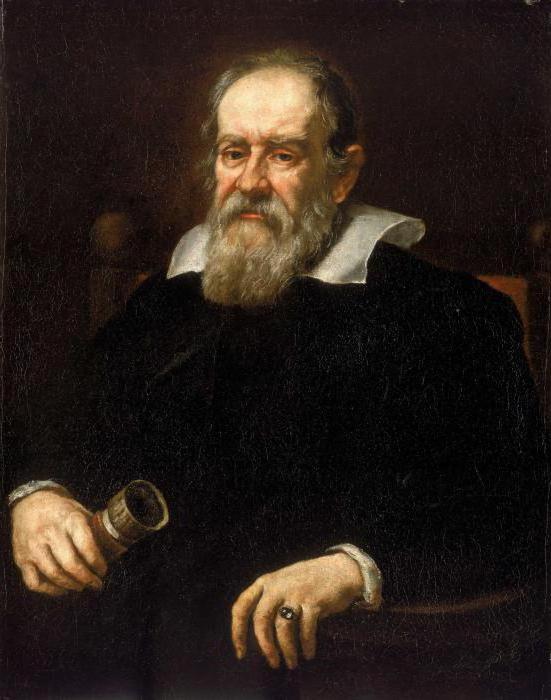
The merit of Galileo Galilei
The history of the discovery of magnifying devices is unthinkable without the name of this man. About 300 years after Bacon's death, Galileo Galilei, a famous scientist from Italy, created a similar pipe. It was not three-, but two-component. Virtually a "peer" of this is a microscope. It is generally accepted that he owes his appearance to Galileo. Galileo parted the telescope and noticed that small objects in this state can be well enlarged. D. Viviani confirms that it was Galileo who invented the microscope. Viviani, by the way, wrote a biography of this Italian scientist.
An important event for science was the discovery of magnifying instruments in 1625. It was then that Faber, a member of the Roman Academy, first used the term "microscope" in relation to the invention made by Galileo.
What was created by Drebel and Alkmar, the development of Tore and Hooke
The history of the discovery of the microscope continues with the work of K. Drebel and Alkmar. These Dutch scientists designed a device that consisted of two convex lenses. Due to this, the image of the object that was viewed under it was presented upside down. This compound microscope, which had a biconvex or plano-convex eyepiece, as well as a biconvex objective, is considered the forerunner of later compound microscopes (one of them is shown in the photo below).

The Italian Tore around 1660 made spherical magnifiers from frozen drops of glass. The history of the discovery of the microscope is inconceivable without this name, since the magnifiers created by the Italian made it possible to magnify objects one and a half thousand times.
Does another name tell you anything - Robert Hooke? This English scientist made a great contribution to the discovery of magnifying instruments. Robert Hooke improved them so much that it became one of significant events in the history of optics. Hooke's microscope diagram is shown in the photo below.
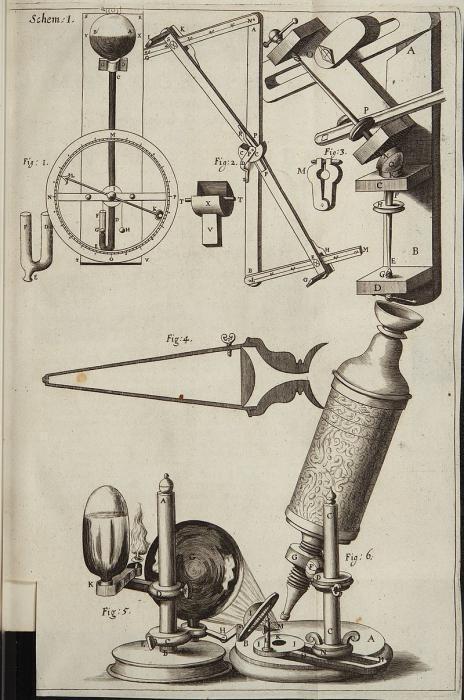
Thanks to this invention, in 1665, Robert was able to see cells for the first time on a section of cork. Thus, such a science as biology received an important technical tool. Magnifying devices continued to improve Leeuwenhoek. Let's talk about him.
Leeuwenhoek and his achievements
A significant contribution to the history of the development of magnifying instruments was made by A. V. Leeuwenhoek, a Dutchman who lived in a city like Delft. The years of his life - 1632-1723. He independently designed and used simple microscopes in research (one of the models of such devices is presented below), capable of magnifying up to three hundred times.
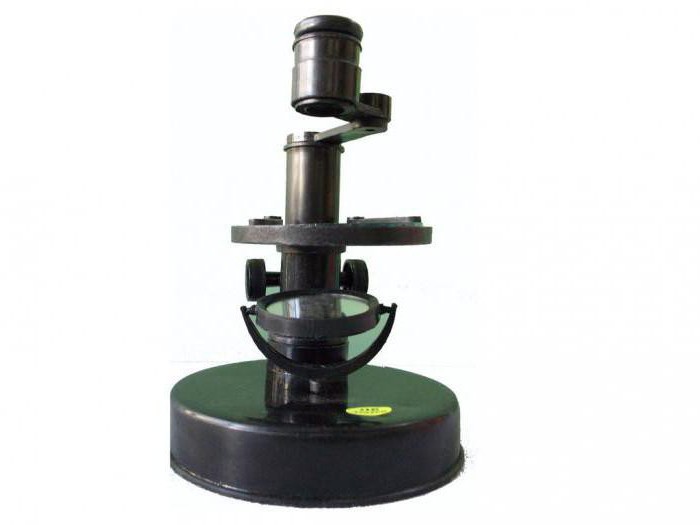
It was Leeuwenhoek who first compiled a description of microscopic organisms (including unicellular bacteria), based on his observations. In 1698, Peter I, the Russian Tsar, paid a visit to this famous explorer. Peter was in Holland at that time and, as you know, was interested in everything new. For his Kunstkamera, which he opened in St. Petersburg, he purchased several complex and simple microscopes. And much later, after the opening of the Academy of Sciences, they were placed at the disposal of this organization.
Works of Russian scientists from the Academy of Sciences
The lesson "Magnifying Instruments" should also include a story about the achievements in optics of representatives of our country. Promising Russian scientists, whose work was led by M.V. Lomonosov, began to use microscopes bought by Peter I in biological research. And later they actively participated in their improvement.
The discovery of magnifying instruments continued in 1747. It was then that L. Euler, a member of the Academy of Sciences of St. Petersburg (years of life - 1707-1783), suggested using an achromatic lens for a microscope. The fundamental work of this scientist in the field of geometric optics is "Dioptric". It consists of three volumes, which were published in 1769-1771. A new microscope, already achromatic, was released in 1802, after the work of Elinus (also a member of the Academy of Sciences of St. Petersburg) was published.
Such a microscope at that time was considered perfect to such an extent that scientists did not even allow the thought that it could be improved. This discovery made a lot of noise at the time. The arrangement of Elinus' magnifying instruments was as follows. They were equipped with six lenses, it was possible to change the magnification smoothly, the distance from the object to the image changed. It was in our country that the idea of an achromatic microscope with variable magnification, important for science, was born and brought to life. However, this idea did not take root in further developments. Changing the magnification of the instrument by adjusting the length of the tube, however, was an important idea that made a significant contribution to the history of development. Today, one of the microscopes created by Elinus can be seen in Polytechnic Museum Moscow, which belongs to the Institute of History, Natural Science and Technology. The photo below shows magnifying instruments dating back to the 18th century.
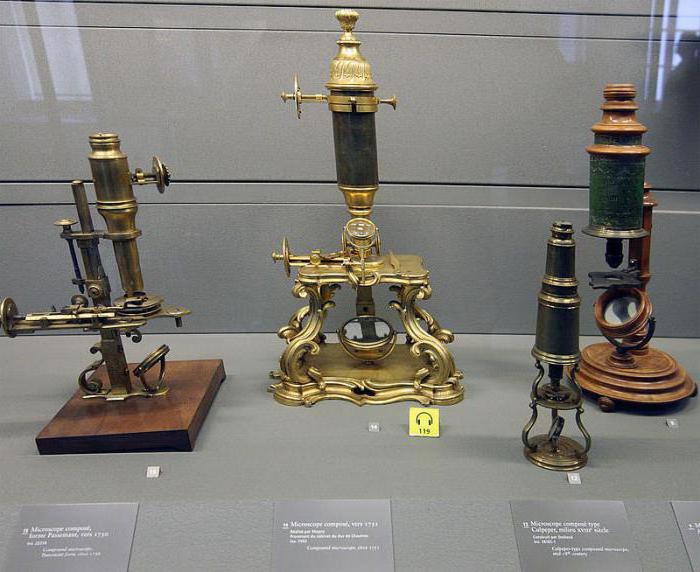
Further improvement of microscopes
J. G. Tiedemann, a German optician from Stuttgart, set about building two achromatic microscopes in the early 19th century. The University of Derpt (today it is called Tartu) gave him cash for the implementation of work. In 1808, these devices were released.
In 1807, a year before the development of achromatic microscopes, Van Dale, a Dutch optician, published his work. It presented a description of the design of an achromatic microscope created by him. Western European historians believe that the first such device of satisfactory quality was the microscope created by this particular scientist. However, in all respects it was inferior to the one designed by Elinus. By the way, the achromatic microscopes of I. Fraunhofer, released in 1811, were distinguished by an even more imperfect design, when compared with the microscopes of Elinus.
Russian microscopes in the 19th century
In the first half of the 19th century, magnifying instruments were already produced in many places on earth. In Russia, their production began in the 18th century, but subsided by the beginning of the 19th century. It is known that around 1820 quite High Quality microscopes were produced by an optics workshop located at Kazan University. However, in Russia there was still no rapid development of this industry, since the government of that time believed that the best option was to buy magnifiers abroad.
Contribution to optics by Giambattista and Amici
Amici Giambattista (years of life - 1786-1863) - a famous Italian optician, astronomer and botanist. He devoted many years of his life to the development of microscopy. In 1827, Amici himself designed and made an achromatic lens with an aperture of 0.60 and good aberration correction. The same scientist in 1844 began experiments on the use of water and oil immersion. Thanks to them, the production of objectives with a numerical aperture of 1.30 and water immersion was launched.
Abbe microscopes
Oil immersion instruments with apertures of 1.50 (which are still in use today) were introduced thanks to the work of Ernst Abbe, a German optician. He invented the law of sines, with the help of which the coma observed in small linear fields was eliminated. E. Abbe continued to develop the theory of image formation in a magnifying device. He also clarified the issue of these devices. Abbe was the head of the work on the creation of a whole series of high quality achromatic microobjectives. Their numerical aperture reached 1.50. These devices were produced in Jena by the company "K. Zeiss" (in 1872). The same company under the leadership of E. Abbe made 8 apochromats. And in 1888, its employees developed an apochromat, which had an aperture of 1.60 and had monobromonaphthalene immersion.
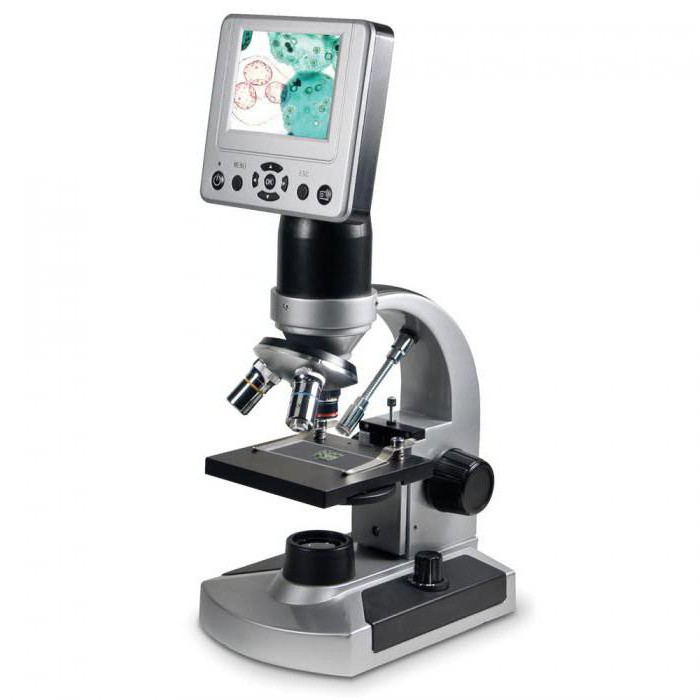
Recent major advances in optics
Russian scientists D. S. Rozhdestvensky and L. I. Mandelstam developed Ernst's theory in their works. An important merit of Rozhdestvensky was that he introduced the concept of relative incoherence of illumination. R. Richter, an employee of the K. Zeiss company, developed and received a patent for a special lighting device used in a microscope. However, the problem of the optimal ratio of the parameters of interchangeable lenses and the lighting system is still relevant today. Domestic microscopes today are in no way inferior in terms of technical performance and optical parameters to devices created by famous companies Abroad.
So, we briefly outlined the history of the emergence of modern microscopes. When developing the lesson "Magnifying Instruments" (Grade 5), you can use the information presented in the article.
Various devices are used for biological research, many of them are technically complex and expensive. During laboratory work it is important to properly handle devices and tools, follow safety regulations. Always Prepare Carefully workplace to work. Place devices and equipment in such a way that they do not fall or tip over.
If we take, for example, a watermelon, an apple, an overripe cucumber or an unripe tomato fruit and break the fruit in half, we will find that inside it consists of tiny grains called cells. In order to see them better, magnifiers are required. The most common are magnifying glass and microscope.
magnifying glass
A magnifying glass is a very simple magnifying device. It consists of glass convex on both sides, usually round, and a frame where it is inserted. There are two types of magnifiers: manual and tripod. A hand magnifier can magnify the object in question by 2 to 20 times. Tripod - 10 - 25 times. framed tripod magnifier two magnifying glasses are inserted, it also has a tripod, is equipped with an object table (for fixing the object in question) and a mirror for adjusting lighting.
Microscope
A magnifying glass allows you to see the shape of cells, but for a real study of their structure, it will not work, and here a microscope will come to the rescue. The word "microscope" itself comes from the Greek words "micros" - small and "scopeo" - look. An ordinary school microscope can magnify images up to 3600 times. Finding out how much the microscope magnifies the image is very simple, just multiply the number indicated on the eyepiece by the number indicated on the objective. If the eyepiece of a microscope gives 10x magnification, and the objective 30x, then it is enough to magnify 10 by 30 to get the number 300 - this is the total magnifying power of this device.
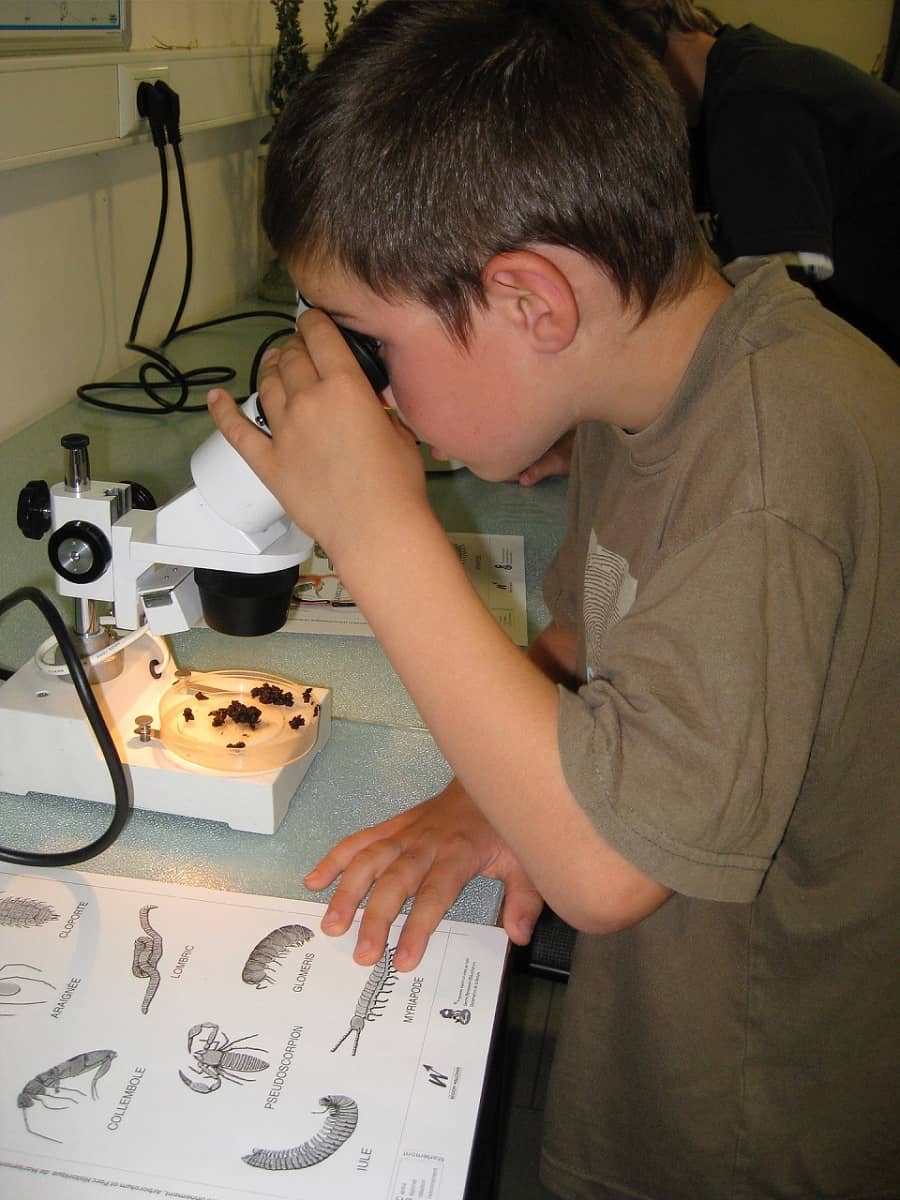
The telescope contains a magnifying glass called a lens. At the very top of the tube, an eyepiece is screwed through which the object under study is viewed. The eyepiece usually consists of a frame and two magnifying glasses. The word "ocular" comes from the Latin "oculus", which translates as eye. The lower end of the tube is equipped with a lens, which also consists of a frame and several magnifying glasses. The word "objective" is derived from the Latin word "objectum" meaning object. The tube is attached to a tripod. An object table with a hole in the center is fixed on a tripod under it. A mirror is fixed under the object table, with which you can adjust the illumination of the object under study. Using the side screw located on the side of the tripod, adjust the distance of the lens above the object under study.
Rules for working with a microscope
- Place the microscope on the edge of the table at a distance of 5 - 15 centimeters.
- Adjust the mirror so that light enters the opening of the stage.
- Place the prepared preparation on the stage and fix it with clamps.
- Gently turning the screw, lower the tube so that it is 1 - 2 millimeters from the object.
- Look into the eyepiece, slowly turn the screw and raise the tube until a clear image of the object appears.
- Treat the microscope with care, store it in a case or a special box.
- Be sure to read the instructions carefully before using the appliance for the first time.
What other magnifying devices do modern scientists use. Prepare short message
Answer:
It is not known exactly when the first magnifiers appeared. So, during the archaeological excavations carried out on the territory Ancient Babylon, scientists found biconvex lenses - the simplest optical instruments. These lenses were made from polished rock crystal. The first microscopes invented by mankind were optical, and their first inventor is not so easy to single out and name. The earliest information about the microscope dates back to 1590 and the city of Middelburg, in Holland, and is associated with the name of Zachary Jansen, who was engaged in the manufacture of glasses. A little later, in 1624, Galileo Galilei presents his compound microscope, which he originally called "occhiolino". A year later, his friend Giovanni Faber coined the term "microscope" for the new invention. One of the first remarkable discoveries related to the improvement of magnifying instruments was made by the English scientist Robert Hooke. Robert Hooke in 1665 first saw cells (cork cut - cells - cells). A contemporary of Hooke, the Dutchman Anthony van Leeuwenhoek (1632-1723), designed a microscope that gives an increase of up to 270 times, and was invented in the 20th century electron microscope, giving an increase of tens, hundreds of thousands of times. Huge contribution Russian scientists contributed to the development and improvement of the microscope. AT early XVIII For centuries, in the workshop of the Academy of Sciences in St. Petersburg, experienced specialists Kalmykov, Belyaev and others produced high-quality structures, and also worked fruitfully to improve these devices. High-quality microscopes were designed by the great Russian inventor IP Kulibin. Quite a lot of research with the participation of a microscope was carried out by the great Russian scientist M.V. Lomonosov. He is considered the first Russian scientist who constantly used this device in his various experiments and studies. Over time, the device of the microscope has evolved markedly, microscopes of a new type have appeared, research methods have been improved.
- What does not apply to the global problems of mankind: 1. Climate change caused by human activities 2 Gap m / y of the copper and rich strata of the population 3. Threat of pollution of the oceans 4 Threat of nuclear weapons proliferation
- Dialogue on how we spent the weekend in October conversation with a friend. Use the following words 1.Barbecue in the countryside 2.Camping in nature 3.watching videos or movies 4.going to an amusement park 5.going to the coast 6.take part in a sporting event 7.watching a sporting event 8.traveling the world 9.going to the theatre/concert/circus
Optical instruments help us explore the world. The telescope allows you to detect and examine the outlines and details of distant cosmic bodies, and the microscope reveals the secrets of our planet, such as the structure of living cells.
When magnifying glasses appeared, people naturally tried to use two such glasses instead of one in order to get even greater magnification. Experimentally, it was found that at a certain distance between the lenses, a distant object can be seen with a significant increase. This arrangement of lenses served as the basis for the creation of the first telescope, which at that time was called a spotting scope. The invention of this device is sometimes attributed to the English philosopher and naturalist Roger Bacon who lived in the 13th century. But perhaps the palm belongs to Arab scientists.
The spotting scope, created in 1608 by the Dutch optician Hans Lippershey, attracted the attention of the Italian scientist Galileo. Within a short time, the scientist improved Lippershey's design and created several pipes with improved characteristics. With their help, he made a number of discoveries, including mountains and valleys on the Moon, as well as four satellites of Jupiter.
Galileo's discoveries showed the importance of the telescope, and the type of instrument he used became known as the Galilean telescope. The convex lens of his objective collected light from the observed object. And the concave lens of the eyepiece deflected the light rays in such a way that they created an enlarged direct image. The lenses were mounted in tubes, one of which (smaller diameter) slid inside the other. This made it possible to adjust the distance between the lenses, while obtaining a clear image.
Galileo's telescope works using the principle of refraction (deflection) of light and is therefore also known as a refractor telescope. Another type of refractor telescope is characterized by the convexity of both lenses. This design creates an enlarged but inverted image and is known as an astronomical telescope.
One major problem with early refracting telescopes was a lens defect called chromatic aberration that caused unwanted color halos around images. To remedy this shortcoming, English scientist Isaac Newton designed the reflecting telescope in the 1660s. To concentrate light rays and create an image, a concave mirror is used instead of an objective lens, which does not form color halos. A flat mirror reflects light into a convex eyepiece lens mounted on the side of the main tube. An instrument of this type is known as a Newtonian telescope.
The magnifying glass is sometimes called simple microscope, since it is used when observing small objects.
A compound microscope consists of two convex lenses. The objective lens creates a magnified image, which is then magnified again by the eyepiece lens. As with an astronomical telescope, this image is reversed. Many compound microscopes have a set of objective lenses with varying degrees of magnification.
- Burns, Robert - short biography
- The concept of common vocabulary and vocabulary of limited use
- Nancy Drew: The Captive Curse Walkthrough Nancy Drew Curse of Blackmoore Manor Walkthrough
- Deadpool - Troubleshooting
- Won't start How to Survive?
- What to do if bioshock infinite won't start
- Walkthrough Nancy Drew: Alibi in Ashes
- Spec Ops: The Line - game review, review Spec ops the line crashes on missions
- Room escape level 1 walkthrough
- Processing tomatoes with boric acid How much will 2 grams of boric acid
- Cucumber Grass (Borago)
- Bioinsecticide Lepidocid: purpose, properties and application procedure Lepidocide waiting period
- How to change the language to Russian in steam
- Dendrobium noble: room care
- Morphology of plants general concepts - document
- Planting, propagation and care of bamboo at home, photo Growing bamboo from seeds
- How to strengthen the cellular signal for the Internet in the country
- Sanskrit reveals the forgotten meaning of Russian words (2 photos)
- The oldest language Sanskrit programming language of the future Dead language Sanskrit
- Who has dominion over all the earth?









